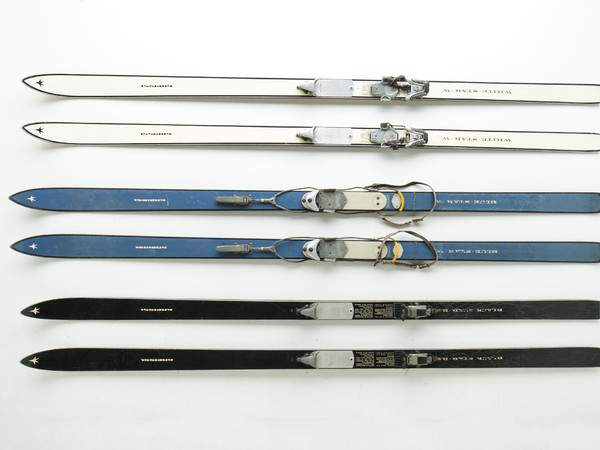From Oct. 11, 2019 to Jan. 12, 2020, Merano Arte is hosting the first comprehensive survey of the production and culture of modern design as it has developed in the Trentino-Tyrol area, located geographically at the center of that crossroads of trajectories that links Munich to Venice, Vienna to Milan.
The exhibition Design from the Alps, promoted and organized by Kunst Meran / Merano Arte in collaboration with NABA, Nuova Accademia di Belle Arti di Milano and the Free University ofBolzano / Freie Universität Bozen, is a tale of the fascinating adventure of design in this Alpine area, which in the last century has proven to be a true laboratory of technical-formal research and elaboration. The exhibition, curated by Claudio Larcher, Massimo Martignoni, and Ursula Schnitzer, presents more than 100 pieces of design covering a wide range of creativity, from furniture components to cameras, from packaging and food products to experiments in aeronautics and auto-motobiking, toys, and sports equipment.
An itinerary punctuated by the most important names in this discipline, from Fortunato Depero to Luciano Baldessari, from Gino Pollini to the two Ettore Sottsasses, from Carlo Abarth to Martino Gamper, and the American writer Ezra Pound.
The exhibition initially analyzes the period between 1919 and 1945 when, the fading of the last secessionist echoes was soon overlaid by a new and experimental attitude to research, in part, stimulated by the programmatic framework of the second Futurism (with the pioneering figure of Fortunato Depero, present in the exhibition with the famous Libro imbullonato, and elements of furniture exhibited for the first time) in part, by the hooks with the new modern trends promoted by Bauhaus and Italian Rationalism.
A generation of great architects, such as Luciano Baldessari, Adalberto Libera, and Gino Pollini (who exhibited a pioneering electric apartment in Bolzano in 1929, as well as Lois Welzenbacher and Clemens Holzmeister) developed during this time. These are joined by the two Ettore Sottsass, senior and junior, who constitute in their family bond a truly unusual unicum, with the latter, Ettore Sottsass junior, born in Innsbruck, raised in Trento, active in Milan, representing in some ways the emblem of all designers born in these lands.
After World War II, it is the effort to keep up with current technological progress that brings to light effective and diversified operational strategies, in accordance with the patterns proper to the season of the economic miracle, which invests above all the specialized sectors of food production, mechanics and transport. Prominent in this segment, the names of Carlo Abarth, a brilliant mechanical inventor, and Gianni Caproni, an aeronautical engineer, entrepreneur and aviation pioneer, but who also devoted himself to motorcycle and motobike production.
From the 1960s and 1970s onward, finally, it is the idea of wide-ranging exchange and confrontation that stands as the privileged perspective, with different authors tuned in to the novelties and stimuli coming from major European centers, such as Dario Montagni, Othmar Barth, Gianni Pettena, Matteo Thun, Marco Zanini, Benno Simma, Baldessari and Baldessari, Kuno Prey, Dante Donegani up to the latest and most important voices of contemporary design such as Harry Thaler, a Merano native but also very busy abroad.
The installation, specially designed for Merano Arte by Claudio Larcher with the collaboration of Manal Abu Monassar and Gaia Dognini (NABA, Nuova Accademia di Belle Arti di Milano), follows the three levels of the historic building in a path that metaphorically resumes an ascent from the plains to the high mountains.
Accompanying the exhibition is an extensive trilingual catalog published by Scheidegger & Spiess (Zurich), with graphic design by Antonino Benincasa with the collaboration of Claudia Gelati and Malthe Wöhler and photographs by Anna Maconi (Free University of Bolzano / Freie Universität Bozen). In addition to specific fact sheets on the objects on display, the volume includes thematic insights by numerous experts such as Christoph Hölz (Universität Innsbruck), Nicoletta Boschiero (head of the Casa d’Depero Futurist Art in Rovereto), Kuno Prey (Free University of Bolzano / Freie Universität Bozen), historian and archivist Hans Heiss, ethnologist and writer Siegfried de Rachewiltz, grandson of Ezra Pound, and artist Gianni Pettena. In addition, historical and documentary research regarding the Tyrolean area was carried out by Ivona Jelcic, an independent author and cultural journalist from Innsbruck.
Pictured: the White Star, Blue Star, Black Star skis of Kneissl (1960s)
Source: release
 |
| From Depero to Sottsass, here is modern design in the Alpine area from Trentino to Tyrol: an exhibition in Merano |
Warning: the translation into English of the original Italian article was created using automatic tools. We undertake to review all articles, but we do not guarantee the total absence of inaccuracies in the translation due to the program. You can find the original by clicking on the ITA button. If you find any mistake,please contact us.